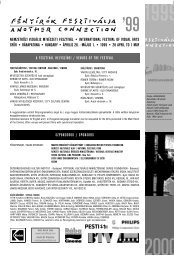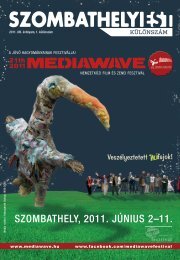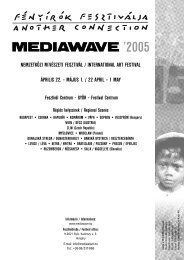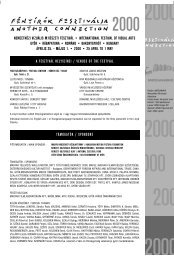Katalógus 2003 - Mediawave
Katalógus 2003 - Mediawave
Katalógus 2003 - Mediawave
You also want an ePaper? Increase the reach of your titles
YUMPU automatically turns print PDFs into web optimized ePapers that Google loves.
VERA BILÁ & KÁLE (CZE)<br />
Csehországi cigány népzene, bosszanova, spanyolos flamenkóelemek és jelentõs<br />
mennyiség magyar népzenei motívum finom, telibe talált arányú elegye<br />
a hat zenész munkájának eredménye. Vera Bilának ereje van. A karizmatikus<br />
kisugárzás akkor is árad belõle, amikor az alacsony termet , igen kövér<br />
asszony nem a mikrofonnál áll, hanem leül a színpad hátsó traktusában lévõ<br />
székre, ölébe teszi a kezét és mozdulatlanul megvárja, amíg véget ér az adott<br />
zeneszám instrumentális része. Na, és amikor feláll, egyenes testtartással<br />
odalép a mikrofonhoz, akkor mindhiába az öttagú zenész-énekes férfi csapat<br />
minden igyekezete; hangja, mozdulatai uralkodóakká válnak. Pedig a kísérõ<br />
Kale (Feketék) zenekar zseniális: két akusztikus, egy elektromos gitár, basszusgitár<br />
és egy férfiénekes csörgõvel, adott esetben tánccal. A zenekar precíz,<br />
senki sem akar feleslegesen elõtérbe nyomakodni, ugyanakkor mind az öt<br />
zenésznek tere nyílik az egyéni megnyilvánulásokra is. Az elõadás könnyed,<br />
profi és fájdalmasan szép.<br />
Singer Vera Bila was born May 22, 1954 in Rokycany in the Gina family of<br />
musicians. While Ms. Bila may sound like a Brazilian pop singer, her band<br />
Kale („Black” in Romany language) sounds remarkably like Gipsy Kings. And<br />
no wonder; this Romany band (as Gypsies prefer to be called) also uses<br />
acoustic guitars and layered male vocals, although the sound is often augmented<br />
by additional instruments. It’s exotic yet homey, Central European yet Latin American. Partially due to the deplorable attitude of many<br />
Czechs towards Romanies, it’s only ironic Vera Bila & Kale are better known in France than in their own country. It could be said that she’s a<br />
star, but Vera Bila has remained herself – success hasn’t changed her in the slightest. She continues to live in a small, modestly furnished flat<br />
in Rokycany, and she continues to repeat to every journalist that she’s still an ordinary woman.<br />
ALANIS OBOMSAWIN (CDN)<br />
NÉPZENE ÉS ETHNO / FOLK AND ETHNO MUSIC<br />
1932-ben született az amerikai New Hampshire-ben, mint abenaki indián. Pályafutását<br />
mint énekes, író és mesemondó kezdte, aki hazai és európai fellépésein<br />
keresztül próbálja megismertetni a világgal népének kultúráját és történetét,<br />
vágyait. 1977 és 1994 között tíz filmet és két jellemrajzot készített<br />
az õslakos életmód különbözõ aspektusairól. Keresve népe igazát, sikerült dokumentálnia<br />
két súlyos indián konfliktust: „Incident at Restiqouche” (1984)<br />
és „Kanehsatake 270 Years of Resistance” címmel. Utóbbi film, az 1990-es<br />
Oka krízisrõl, az ezredvég elhallgatott, nagy (fegyveres) észak-ameikai indiánlázadásáról<br />
szól, 13 filmfesztivált nyert (a MEDIAWAVE-en is!) és egyedül<br />
Japánban mintegy 23 millió TV nézõ láthatta. Legújabb filmje ismét a MEDIA-<br />
WAVE’ <strong>2003</strong> versenyprogramjában van.<br />
Nagyon szeret emberekkel dolgozni, rendszeresen tart elõadásokat a hagyományokról,<br />
fellép iskolákban, m velõdési házakban, börtönökben és gyakran<br />
a televízióban és zenei fesztiválokon is. Több fontos hivatali funkciót is betöltött,<br />
több tucat kitüntetést is kapott az évek folyamán, ilyen például a Kanadai<br />
Érdemrendi kitüntetés, a Szövetségi Kormány legmagasabb kitüntetése stb.<br />
Ragaszkodása jeleként népe úgy hívja õt, hogy Ko-li-la-wato, azaz „valaki, aki<br />
nagyon boldoggá tesz bennünket”.<br />
An Abenaki Indian, Alanis Obomsawin started off as a singer, writer and<br />
storyteller, seeking through her performances in North America and Europe<br />
to make known the history, culture and aspirations of her people. Between<br />
1977 and 1994, she made ten films and two vignettes illustrating different<br />
aspects of Aboriginal life. Committed to the cause of justice for her people, she documented two major confrontations, Incident at Restigouche<br />
(1984) and Kanehsatake 270 Years of Resistance. The latter film, about the Oka crisis in 1990, has won 13 awards and international acclaim,<br />
and was seen by 23 million TV viewers in Japan alone. Her latest film is to be seen at MEDIAWAVE'<strong>2003</strong>. Obomsawin produces most of her<br />
films herself.<br />
She has an enduring interest in education and a preference for working closely with people. In 1982, she taught a course on oral tradition as<br />
a guest of the Music Department at Dartmouth College in New Hampshire. She readily agrees to perform at schools, community halls and prisons,<br />
and frequently appears on television and at music festivals. Obomsawin chaired the Board of Directors of the Native Women's Shelter<br />
of Montreal for many years and sat on the Canada Council’s First Peoples Advisory Board. She was also a board member of Studio One, the<br />
NFB's Aboriginal unit, and served as an advisor to New Initiatives in Film, Studio D’s program for women of colour and First Nations women.<br />
She has received a dozen awards and honours over the years, including the Order of Canada, the federal government’s highest honour, in<br />
1983. Her films have picked up more than 30 awards at international festivals. As a mark of affection, her people call her Ko-li-la-wato –<br />
„someone who makes us very happy”.<br />
19







